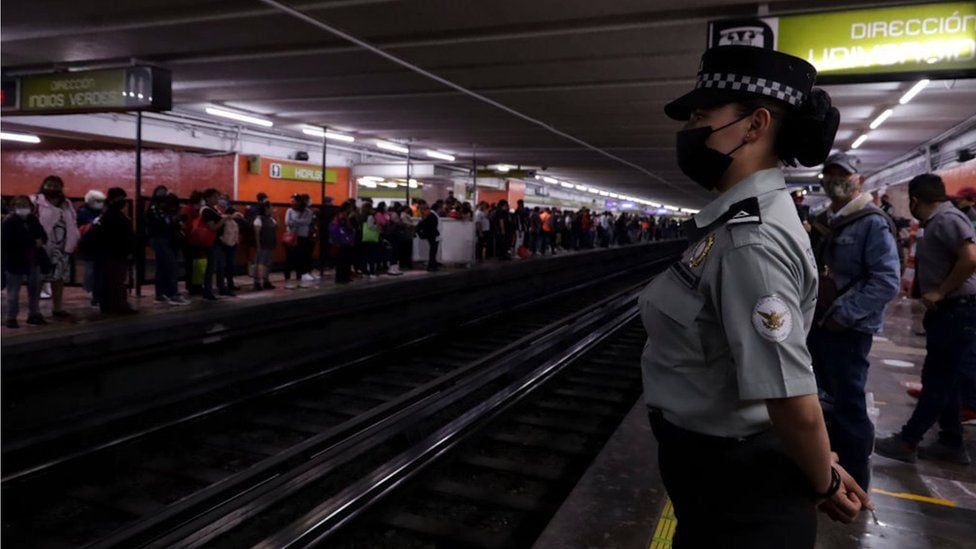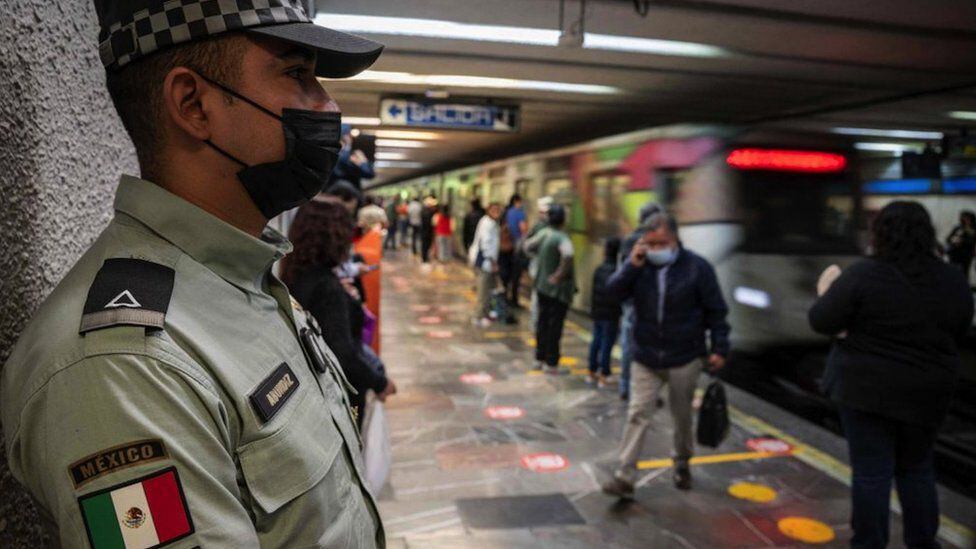:quality(75)/cloudfront-us-east-1.images.arcpublishing.com/elcomercio/GE3DAMJNGAYS2MJXKQYDAORRGY.jpg)
The city subway Mexico chains one incident after another recently and the authorities opted for a measure not without controversy to try to solve it: resort to the National Guard.
The last event recorded in this public transport network, which before the pandemic served some 4.6 million passengers a day and is essential for the transfer of many Mexicans to their jobs, occurred this Sunday when two of the carriages they separated and the Polanco station had to be evacuated.
Look: Mexico: Line 12 of the subway will reopen after fatal accident
But the list of incidents is long. For this reason, the head of government of Mexico City, Claudia Sheinbaum, announced last Thursday the deployment “for a few months” of more than 6,000 National Guard agents to monitor the extensive metro network and try to stop these episodes.
The announcement, which was received with skepticism by many users who found uniformed officers at subway stations over the weekend, was criticized by those who believe that the accidents are due to to lack of maintenance and not to insecurity.
And this raised great doubts about what will be the role that the National Guard will be able to play in the face of, for example, possible technical failures. But authorities have labeled some of the recent incidents as “unusual”, pointing out that it could be intentional sabotage, so the presence of the agents would be justified.
In addition, the measure collided with human rights organizations that ensure that the deployment of the National Guard, a body dependent on the Ministry of Defense, involves militarizing a transport of civilian users, something that the Mexican president himself has denied.
Long history of incidents
The accident on Sunday in Polanco is already being investigated by the Mexico City Attorney General’s Office.
This Monday, the director of the metro, William Calderon, He assured that the train had undergone maintenance work a few days before and pointed out as a preliminary cause the discovery of a loose screw and another with a cut throat, something that he described as an “atypical” event.
That same Sunday, when the National Guard was already operating in its new metro surveillance function, the service had to be momentarily stopped after a metallic object fell to the track at the Bellas Artes station.
But the issue was once again at the center of controversy on January 7, when a collision between two trains resulted in the death of a young woman and dozens of injuries. Sheinbaum revealed that the black box had been stolen and later located in a van.
The municipal government described this Monday as “premeditated and malicious” these latest incidents that have already been reported. “We do not point to anyone, let the Prosecutor’s Office investigate. All our recognition to the workers,” said the head of government of the Mexican capital.
The truth is that, almost daily, disgruntled users express their complaints about the operation of the underground and the multiple breakdowns it presents on social networks. Last Wednesday there was a fire in one of the trains and, three days before, the fall of an electrical cable temporarily affected the service.
Faced with accusations that the failures may be due to a lack of maintenance, Sheinbaum assured that the metro has more resources this year than the previous one, although it is true that the budget was lower during the covid-19 pandemic due to the decrease in users and the comparative does not take into account inflation accumulated each year.
Although she did not rule out that the budget could be reinforced, the official recalled other important investments such as the modernization that will conclude this year of line 1, the oldest and most used in a subway inaugurated in 1969.
Precisely this Sunday, part of line 12 was reopened, which was closed after the tragic collapse of two carriages traveling on an elevated section and which left 26 dead in 2021, which reignited the debate on maintenance and failures in its construction.

That same year, a fire at a checkpoint killed one person and knocked out six subway lines.
Rain of criticism for the “militarization” of the subway
The supposed solution to these incidents, the deployment of the National Guard in the subway to monitor it, fueled the controversy over the growing power that the current Mexican government has given to the military, which, beyond public security, also builds airports and rail systems.
With this measure “attempts against the principle of exceptionality, paying to the process of normalizing the militarization of the country”, criticized Amnesty International in a statement.

As the Miguel Agustín Pro Juárez Human Rights Center tweeted, the announcement “is worrisome, since it is clear that this corporation reproduces the military inertia of opacity and excessive use of force. We call for extraordinary supervision mechanisms to be activated.”
The possible appearance of conflicts derived from the treatment of these agents towards the civilian population “is a risk that is run, undoubtedly,” the security specialist tells BBC Mundo Javier Oliva, although he points out that many of them are trained for aid plans for the civilian population in cases of disasters, despite being “a different context.”
Other analysts questioned their preparation for this performance even in the event that we were facing sabotage actions and not failures due to lack of maintenance.
“A sergeant trained to combat is going to take care that the hydraulic systems of a wagon have been verified by the mechanics?”, asked the columnist of the newspaper Milenio Roman Revueltas Retes in an article entitled “Police instead of railway technicians?”.

“Watching trains and passengers go by does not seem like the best way to identify conspirators. In any case, it would seem much more useful to have a group of investigators, backed up by technical specialists, who could pull the strings of the various incidents and find the possible culprits.” , the security expert wrote in the newspaper El Universal Alexander Hope.
“But if it is considered that additional vigilance is needed, why use the National Guard for that purpose? Mexico City has 90,000 of its own police officers,” he added, while considering that the decision responds to more political purposes than operational.
“You had to come up with some kind of fancy response, whether or not it was helpful in dealing with the supposed threat. Putting a lot of National Guardsmen patrolling the system fits into that logic.”
Objective of “caring for the people”
The Mexican President, Andres Manuel Lopez Obrador, He responded to these criticisms by assuring that the objective of the deployment is “to take care of the people.”
“What if they are provoked acts and what they want is for a greater misfortune to happen? Are we not going to avoid it because they are going to say that we are militarizing the country?” he questioned last week.
“We are going to have surveillance and if they call that militarization, or whatever they call it, We assume responsibility, because prevention is better than regret”, added.
Sheinbaum, for his part, assured that the presence of the National Guard in the subway is “totally legal” and defended that “it is there to care for and protect users.”
“For all those who say that it is a militarization of the Metro, it is absolutely false: the National Guard is an institution of our country and it is so false that They’re not even armed.” answered.
The authorities did not offer details on what the specific functions of the agents in the subway will be, except that “they will inhibit actions against the infrastructure, trains and users” as a “preventive action” with tasks of “social proximity”.

According to the expert Oliva, the agents will probably focus on situations that may occur on the platforms such as incidents in which they have to lead an eviction from the station, for example. He also believes that their presence could translate into a reduction in the number of fights between users or pickpockets.
“But I think that the issue of these accidents that we are seeing is actually in the workshops, in the maintenance areas of the trains,” assures BBC Mundo.
The government strategy also calls for the deployment of some 50 agents as undercover “simulated users” among passengers. Likewise, they will work in coordination with the thousands of police officers who already perform surveillance tasks in the transportation system.

The truth is that the authorities’ explanations did not stop protests such as the one organized by a group of people last Friday under the slogan “Get the National Guard out of the metro”, which ended with destruction of part of the facilities.
That same day, the video of the arrest by the National Guard of a young man who was demonstrating in the subway against his presence went viral. The capital authorities reported that the detainee had painted the facilities.
However, the director of the metro assured shortly after that the young man had been released without any penalty and that Those responsible for his arrest were suspended.
Source: Elcomercio
I am Jack Morton and I work in 24 News Recorder. I mostly cover world news and I have also authored 24 news recorder. I find this work highly interesting and it allows me to keep up with current events happening around the world.






